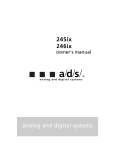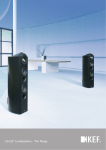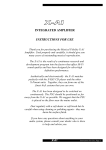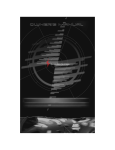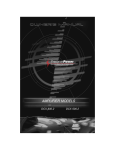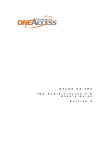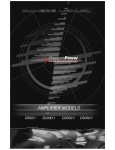Download a/d/s/ 346cs Owner`s manual
Transcript
345cs 346cs owner's manual analog and digital systems table of contents introduction . . . . . . . . . . . . . . . . . . . . . . . . . . . . . . . . . . . . . . . . . . . . . . . . . . . . .1 about this manual . . . . . . . . . . . . . . . . . . . . . . . . . . . . . . . . . . . . . . . . . . . . . . . .1 features . . . . . . . . . . . . . . . . . . . . . . . . . . . . . . . . . . . . . . . . . . . . . . . . . . . . . . . .2 cautions . . . . . . . . . . . . . . . . . . . . . . . . . . . . . . . . . . . . . . . . . . . . . . . . . . . . . . . .2 installation planning . . . . . . . . . . . . . . . . . . . . . . . . . . . . . . . . . . . . . . . . . . . . . . .3 amplifier requirements . . . . . . . . . . . . . . . . . . . . . . . . . . . . . . . . . . . . . . . . . . . . .3 mounting locations . . . . . . . . . . . . . . . . . . . . . . . . . . . . . . . . . . . . . . . . . . . . . . .3 crossover features and connections . . . . . . . . . . . . . . . . . . . . . . . . . . . . . . . . . . .4 speaker wiring . . . . . . . . . . . . . . . . . . . . . . . . . . . . . . . . . . . . . . . . . . . . . . . . . . .5 speaker installation . . . . . . . . . . . . . . . . . . . . . . . . . . . . . . . . . . . . . . . . . . . . . . .5 tweeter installation . . . . . . . . . . . . . . . . . . . . . . . . . . . . . . . . . . . . . . . . . . . . . . .6 crossover installation . . . . . . . . . . . . . . . . . . . . . . . . . . . . . . . . . . . . . . . . . . . . . .9 connecting the system . . . . . . . . . . . . . . . . . . . . . . . . . . . . . . . . . . . . . . . . . . . . .9 crossover connections and input switch setting . . . . . . . . . . . . . . . . . . . . . . . . .10 bi-amplified connections to crossover . . . . . . . . . . . . . . . . . . . . . . . . . . . . . . . . .11 bi-wire connections to crossover . . . . . . . . . . . . . . . . . . . . . . . . . . . . . . . . . . . .12 troubleshooting . . . . . . . . . . . . . . . . . . . . . . . . . . . . . . . . . . . . . . . . . . . . . . . . .13 specifications . . . . . . . . . . . . . . . . . . . . . . . . . . . . . . . . . . . . . . . . . . . . . . . . . . .14 warranty information . . . . . . . . . . . . . . . . . . . . . . . . . . . . . . . . . . . . . . . . . . . . .15 introduction Thank you for choosing a/d/s/® automotive component loudspeakers. These reference quality speakers combine the acoustic excellence achieved from 30 years of loudspeaker research and development, with innovative and timeless industrial design, and cutting edge material choices. Tuned for precise reproduction of the supplied musical signal, they accurately deliver every nuance and detail while retaining the classic "a/d/s/® sound" that has enchanted multiple generations of owners. With a minimum of care, this high performance component speaker system will deliver years of trouble-free satisfaction. about this manual To achieve optimum performance from your a/d/s/® automotive component loudspeakers, we recommend that you read this manual thoroughly before installation and use. For the best results and support, please consult with your local authorized a/d/s/® retailer. Technical support is also available from a/d/s/® at 1-800-753-0800 x2033. Keep this manual in a safe place for future reference. 1 features Molded woofer basket - The backbone of any good woofer is its basket. It provides the proper alignment and support structure for the magnet and moving parts while the very thin braces guarantee a minimum of early reflections off the basket that would be ordinarily transmitted as sonic colorations through the cone. Woofer cone - Anodized aluminum cones provide the perfect combination of rigidity and low moving mass for ultra-low distortion and superior transient response. Vented voice coil - Magnet cooling vent construction enhances power handling capabilities of the woofer. Extended center pole - Woofer magnet geometry provides a symmetrical magnetic pattern to reduce THD. Tweeter - Ultra-light silk dome design is treated with polymer compound to control all non-linear resonances. Multi-mount tweeter - The following mounting options (surface, angled surface, flush, or angled flush) are supplied to mount the ferrofluid cooled neodymium tweeter. Tweeter level control - A three-position switch adjusts the volume of the tweeter with respect to the midrange. Tweeter phase switch - A two-position switch which allows 180° or 0° phase difference between the tweeters and midranges. Midrange contour control - A two-position switch offers a frequency response correction circuit to adjust for flat frequency response in the car on axis or off axis. Bi-amplifiable/ bi-wirable - The passive crossover supplied with this system is bi-amplifiable or biwirable; typically only available in high quality audiophile home loudspeakers. Solid state tweeter protection - Advanced protection circuitry provides protection for the tweeter against overpowering or amplifier clipping. cautions Study your automobile thoroughly before you drill or cut any holes. Take extra care when working near gas tanks, gas lines, brake or hydraulic lines and electrical wiring. Wear eye and ear protection when using power tools. Keep the woofers and tweeters away from metal filings and shavings. Once foreign objects are stuck to the magnets or tweeter dome, it will be virtually impossible to remove them. Keep the tweeters in their protective bags until final mounting to prevent any possibility of metal dust or chips from passing through the grille and accumulating on the dome. Exercise caution when working with the cs series with the grille removed. A slip of the hand with a screwdriver or other tool can result in irreparable damage to the cone or dome. Do not touch the cone or dome. Do not install the components where they will be subject to excessive heat, moisture or dust, or where they will be kicked or repeatedly bumped or brushed. Make absolutely sure that the woofer is connected to the lowpass output and the tweeter is connected to the highpass output of the crossover network. If these connections are reversed, low-frequency signals will be fed to the tweeter without fuse protection. In this case, the tweeter may be damaged, such damage is not covered by the warranty. When removing or installing the grills be careful not to brush the woofer's rubber surround or the tweeter's dome with the edge of the grille. Cutting or tearing the surround or dome will destroy the unit. 2 Never run wires outside or beneath the vehicle where they can be snagged by road hazards or the moving parts of the vehicle. Use existing wire channels, sills, panels and molding strips inside the automobile to hide the wiring for neat appearance and safety. Make sure your radio/cassette/cd player and or other equipment is turned off while connecting the speaker terminals. Turn on the various components and slowly advance the volume control ONLY after checking and double checking all connections. NOTE: If the sound is weak or distorted, immediately turn down the volume and see the section entitled Troubleshooting. installation planning Proper installation planning is the best way to maximize performance. By planning your installation carefully you can avoid situations where the performance or reliability of your system is compromised. Your authorized a/d/s/® dealer or a/d/s/® audio technical support at 1-800-753-0800 x2033 has been trained to know how to maximize your speakers sonic potential. They are a valuable resource in helping you with your system design and installation. amplifier requirements This speaker system requires a minimum of 45 watts per channel to achieve reasonable listening volumes in a moving automobile without clipping the amplifier. a/d/s/® recommends no more than 150 watts per channel as a maximum so as not to exceed the thermal or mechanical limitations of the speaker system. Any amplifier between 45 watts and 150 watts may be used. If you choose to use an amplifier with more than 150 watts use caution as speaker damage may occur at high volume settings. All a/d/s/® loudspeakers will produce reasonable volume levels in the automotive environment using moderate amplifier power. However, the use of a low powered amplifier to try and attain very high volume levels can lead to overdriving the amplifier and damaging the speaker system. As a rule, do not turn the volume up above the point where you hear distortion on musical peaks from either an overdriven amplifier or mechanical noise from an overstressed speaker. For the best performance and reliability; select an amplifier with slightly more than the maximum power you are likely to need to generate the desired volume levels. This margin of reserve power will ensure that the amplifier will not be routinely driven beyond its design limits. WARNING: Excessive sound pressure level can permanently damage your hearing. The maximum volume levels attainable with a/d/s/® speakers, combined with high-power amplification, may exceed safe levels of extended listening. mounting locations There are many possible choices of mounting locations. The vehicle factory locations will usually dictate the woofer mounting position. Because of its small size and multiple mounting options, the tweeter can go virtually anywhere. a/d/s/® uses an unusually low crossover frequency for the tweeter which means you are not restricted to mounting the tweeter close to the midrange speaker. The tweeter can be mounted as far as 24" (60 cm) from the midrange speaker without causing adverse effects on the sound quality. However, better results are usually obtained by locating the tweeters and midranges relatively close to each other, and by keeping the sound path lengths between the listener and the left and right speakers as equal as possible. a/d/s/® cannot recommend specific tweeter mounting locations for each vehicle, but in general try to keep the tweeters as far to the sides of the car as practical. Avoid placing them above ear level unless the woofers are also above ear level. Place the tweeters in similar locations on both sides of the vehicle. Try a few locations by just placing the tweeter or taping it in a location and listening to ensure the desired stereo image and high frequency dispersion are achieved before committing to a location by drilling holes in the vehicle. You should also experiment with the tweeter phase switch settings to find the most effective combination of location and phase. 3 crossover features and connections Tweeter DC Clip Protection Tweeter Thermal Breaker Midrange Contour Switch Tweeter Phase Switch Parallel Bi-amp Switch Tweeter Level Switch IN OUT Woofer Tweeter Woofer Tweeter + + + + demo car 180° p b 0 -3 0° +3 Midrange Contour switch Positions of Demo or Car are provided to offer different contours to midrange woofer frequency response. This switch should be left in the Car position for most applications. Bi-amp/Parallel switch Select the Bi-amp position if you intend on driving the woofers and tweeters with separate amplifiers (four channels). Select the Parallel position if you intend on driving the woofers and tweeters with the same amplifier (two channels). Tweeter Level switch The three-position switch in the crossover box adjusts the output level of the tweeter. The mid-position (0) is referenced as equal output from the midrange speaker and the tweeter. The high position (+3) provides 3dB more output from the tweeter. The low position (-3) provides 3dB less output from the tweeter. Select the position of this switch for your listening preference. Tweeter Phase switch Select 0 or 180 degrees phase relationship between the tweeters. Select the position of this switch for your listening preference. Tweeter Thermal breaker This component protects the tweeter speaker if too much power is delivered to the tweeter. If activated the tweeter will briefly stop producing sound until the breaker automatically resets. Tweeter DC Clip Protector These components limit the amount of current delivered to the tweeter if they are overdriven by either excess amplification or clipped signal from an overdriven amplifier. Connections to the amplifier The crossovers are supplied with a removable screw type connector. The crossover has two sets of input terminals, this allows the system to be driven by either two or four channels of amplification. To correctly use these wiring schemes you must move the Bi-amp/Parallel switch to the desired position. 4 To bi-amplify the system you will need two stereo amplifiers (or 4 amplifier channels) with one pair of channels to drive the tweeters and one pair to drive the woofers. You may also Bi-wire the system by connecting the woofer input terminals to the amplifier and connecting the woofer input terminals to the same amplifier with another set of speaker wires. This is sometimes done to allow a specific high frequency or low frequency cabling to be used for the two separate signal paths. See Crossover Installation for additional information on bi-wiring. Be sure to connect the positive crossover terminals to the positive speaker terminals and positive amplifier terminals, also ensure that the negative crossover terminals connect to the negative amplifier and speaker terminals. Once all of the wires are attached to the connector and the crossover is mounted, the connector can be plugged into its mating receptacle on the crossover. speaker wiring Speaker wire selection Use insulated two-conductor stranded wire to connect the crossover to the speakers and amplifier. The size of the wire can have an audible effect of the performance of the system. Stranded 18 gauge "zip cord" will work, but can result in lower output or unpredictable frequency response. For wire runs of 50 feet (15 m) or less, we recommend 16 gauge or larger wire. The crossover connector will accept up to 14 gauge wire. Polarity and phasing The polarity of the positive/negative orientation of the connections for every speaker and amplifier connection must be consistent so all the speakers will be in phase. When the polarity of one connection is reversed, bass output may be reduced or stereo imaging degraded. Most speaker wire is marked so you can identify the two conductors. There may be ribs or a stripe on the insulation of one conductor, or the wire may have clear insulation with different color conductors (copper and silver). There may also be polarity indications printed on the insulation. Identify the positive and negative conductors and be consistent with every speaker and amplifier connection. The supplied speaker wire has a white stripe to indicate the (+) positive conductor. Termination The woofer uses an angled locking screw connection integrated to the basket of the speaker. The tweeter wires are terminated with molded connectors (male and female). Use the supplied wire with insulated connectors to extend the tweeter wires to the crossover section. Alternatively you may solder the tweeter wire connections and insulate them with high quality heat shrink tubing. speaker installation Woofer installation The woofer will fit into many standard factory mounting locations using the existing mounting holes in the automobile. Remove the trim panels and inspect the installation locations before you cut and drill the holes required to mount the woofer. Removing the panel will also make it much easier to route wiring inside the door. Look for original equipment speaker installation cutouts that can be used to install the woofers with little or no modifications. Use the supplied template to help you locate and mark the holes needed to install the speakers. If the planned installation location is in a door panel, be sure the speaker will not interfere with the window lowering mechanism. Ensure that the speaker wires are positioned to clear all moving parts inside the door. For each woofer you will need to cut one large hole and drill small holes around the circumference. If the mounting surface is covered by carpet or fabric, use a knife or razor to cut the material away from the 5 holes to be cut. This prevents material or fibers from becoming tangled in the drill bit or cutting blade. If you are using the packaged metal screws provided in the hardware kit, drill the four speaker mounting screw holes with a 1/8"(3 mm) drill. Clean the work areas of all filings and shavings with a vacuum cleaner before you proceed with woofer mounting. Woofer mounting Route the speaker wire from the woofer installation locations to the crossovers. Pull the wire through the installation hole and attach the terminals on the ends to terminals connections on the speakers. Refer to the speaker wiring section of this manual and the wiring diagrams. Push the wire back into the area behind the installation location and be sure it will not interfere with the speaker or get snagged by any mechanisms in the area. Attach the supplied foam gasket strip to the mounting surface of the speaker. This will ensure an air tight seal, which is required to achieve the best bass performance. Install the speakers by gradually tightening each mounting screw. Tighten the screws until the speaker is well seated, but take care not to over-tighten. tweeter installation The speaker system is supplied with four different tweeter mounting options: surface, surface angle, flush, and angled flush mount. After you have decided which option is best suited to your installation, refer to the following sections for specific details on mounting the tweeter. Surface mount (Straight or Angled) The preparation of the mounting surface for the tweeter involves drilling three holes. Two holes are for the mounting screws. Their centers must be spaced 15/16” (24 mm) apart. Use a 1/8" (3 mm) drill bit for the supplied screws to mount the cup. The third 1/4” (7 mm) hole is required for the wire to pass through. Use the template provided to locate the hole centers. Cut carpeting or fabric away from the hole locations to prevent tangling of fibers in the drill bit. Surface mount (Straight or Angled) Mounting slots (qty 4) #6 x 3/4" screws (qty 2) Insert two #6 x 3/4" flat head sheet metal screws through the holes in the bottom of the surface mount cup. Screw the cup in place. Ensure the mounting screws are driven in straight, so the heads sit flush on the cup mounting surface. This ensures the tweeter will seat properly in the surface mounting cup. The tweeter is then slid into the mounting cup (tabs aligned with the mounting slots), and turned counterclockwise to lock in place. NOTE: The mounting cup is also supplied with an angled surface mounting cup (not shown). This allows the tweeter to be mounted at an optimum acoustic angle for the listener. Follow the same procedure as above to mount and assemble the tweeter in this housing. 6 Flush mount (Surface or Angled) NOTE: Ensure that there is enough clearance within the interior door panel for the M4-0.7 X 4-1/2 cm (1.77 inches) flat head mounting screws. Reduce the length of the mounting screw as necessary to meet clearance. Check the intended installation site to be sure that there is sufficient depth behind the mounting surface for the rear cup and mounting screws. The minimum depth required behind the back of the mounting surface is 1" (25 mm). The front cup mounts into the mounting through a 1-7/8" (48 mm) diameter hole. Be careful that the hole does not exceed 2-1/8" (55 mm) diameter at any point so that the rim of the cup will completely cover the edge of the hole. Metal mounting bracket Mounting slots (qty 4) M4-0.7 x 4-1/2 cm screws (qty 2) Flush Angled Mounting Cup Use the template provided to locate the hole centers. Cut carpeting or fabric away from the hole locations to prevent tangling of fibers in the saw blade. Insert the two M4-0.7 X 4-1/2 cm (1.77 inches) flat head metal screws through the mounting holes and just start the threads into the metal mounting bracket. With the metal bracket attached to the mounting cup slide one end of the metal bracket and then the other end into the mounting hole. Hold the mounting cup in its final position and tighten, but do not over tighten the two mounting screws. The tweeter is then slid into the mounting cup (tabs aligned with the mounting slots), and turned counterclockwise to lock in place. NOTE: The mounting cup is also supplied with an angled surface mounting cup (not shown). This allows the tweeter to be mounted at an optimum acoustic angle for the listener. Follow the same procedure as above to mount and assemble the tweeter in this housing. Tweeter mounting Route the wire from the crossover locations to the tweeter locations. Pull the wire through the wire hole and attach crossover wires to the wires from the tweeters. Connect the positive wire to the positive (+) terminal of the tweeter, which is marked with the white trace. See the information in the speaker wiring section of this manual and the wiring diagrams. Push the wire back into the area behind the installation location and be sure it will not interfere with the speaker or with anything behind the mounting panel. To attach the tweeter to the surface or flush mount assembly, align the tabs in the mounting cup with the relieved areas in the tweeter mount. 7 Mounting Screws Tweeter Tweeter TWEETER Tweeter Wiring Surface Mount Housing Panel Bolts Tweeter Wire Panel Flush Mount Housing Wiring Bracket Wiring NOTE: The tweeter grill can be easily removed for coaxial applications, or to facilitate mounting the tweeter behind an existing factory grill. Use the supplied black butyl material to attach the tweeter grill for all other applications. 8 crossover installation The system supports conventional wiring, Bi-wiring or Bi-amping using the supplied passive crossovers. While conventional (parallel mode) wiring will provide excellent sound, bi-wiring or bi-amping may further enhance the performance in no-compromise systems. Bi-wiring uses a separate pair of speaker wires for the high frequency and low frequency signal between an amplifier channel and its associated crossover network. This gives you the option of choosing wire which may have slightly different sonic characteristics in order to optimize performance of each frequency range. Also, it reduces the overall wiring resistance between the crossover and amplifier, much like the use of larger gauge wire. This option provides the most benefit when the crossover network is mounted a long distance away from the amplifier. If the crossover is mounted close to the amplifier it is doubtful that there will be an appreciable difference between bi-wiring and conventional wiring. Bi-amping uses a separate amplifier channel for the high-frequency and low-frequency sections, instead of the single amplifier channel used in conventional and bi-wired connections. Bi-amping provides the additional advantage of allowing use of the amplifier's level controls to provide an additional level of finetuning not possible with the tweeter-level switch alone. In addition, at high power levels, a bi-amplified connection can help protect the tweeter from amplifier clipping, which is more likely to occur on channels driving the midrange. When bi-amping using the passive crossovers, the midrange low-pass filter and tweeter high-pass filter on the amplifier or external active crossover should be bypassed. Carefully route the wires from the woofer and tweeter to the crossover mounting location. The crossover installation location should be reasonably accessible to allow easy connection of the wires and adjustment of the internal switches. If the crossover must be mounted in an inaccessible location make the speaker wire connections and adjustments before final installation. Be sure the installation location has adequate clearance to allow the removal and replacement of the cover. Mounting the crossover requires removing the top cover of its housing. Grasp the top cover at the front and back. Compress the cover slightly in the center and lift it off the bottom of the housing. Mounting the crossover requires four holes in a rectangular pattern 2 13/16" x 4 1/4" (7.14 cm x 10.8 cm) on a flat surface. Use the crossover as a template for drilling the mounting holes. Align the mounting holes in the bottom half of the crossover unit with the holes you have drilled at the installation site. Pass the four #6 x 1 1/4" screws through the holes in the crossover unit, and tighten them until the assembly is firmly in place. As before, do not over-tighten; this is especially important if the mounting surface is not perfectly flat. After all the connections and any necessary adjustments have been made snap the cover back in place. connecting the system Trim the speaker wire as needed. Strip about 1/4" (6 mm) of the insulation from the ends. Twist the exposed strands thoroughly to prevent any loose strands from causing a short circuit. You may also "tin" the wire with a soldering iron. The wires attach to a removable connector which in its assembled position has the screws facing the bottom of the crossover. Insert the prepared wire into the appropriate location (see diagram or refer to the crossover circuit board) in the connector strip and tighten the screws to secure the wires in place. Be sure to note the polarity marking on the circuit board. 9 crossover connections and input switch setting Route the wires connected to the input terminals on the crossover network to the power amplifier. Connect the wires to the amplifier outputs as recommended by the manufacturer of the unit. Make sure there are no stray strands of wire which could cause a short circuit. Observe left/right polarity markings. Standard (Switch in Parallel Position) Tweeter P B IN + + - - + + - OUT + Tweeter - Tweeter Woofer Crossover Amplifer - Woofer + Woofer - - + NOTE: In this configuration, you may connect the amplifier (+) positive to either the tweeter (+) or woofer (+) terminal, and the amplifier (-) negative to either the tweeter (-) or woofer (-) terminal. The parallel switch ensures that both halves of the crossover are supplied with signal as least one (+) and (-) input terminal are connected. 10 bi-amplified connections to crossover Connections from the crossover to the woofer and tweeter are the same as the normal wiring method. Connect the amplifier you have chosen for the tweeter to the “Tweeter In” terminals input. Connect the woofer amplifier to the “Woofer In” terminals. NOTE: You must move the selectable switch to the Bi-amp position. Failure to set the switch correctly may cause damage to the amplifiers or the crossover. Bi-Amplified (Switch in Bi-amp Position) Tweeter P + B IN + - OUT Tweeter Amplifer - + - + Tweeter - Tweeter Woofer Crossover + + - Woofer + Woofer - - + Woofer Amplifer - 11 bi-wire connections to crossover Connections from the crossover to the woofer and tweeter are the same as the normal wiring method. Connect the amplifier to the tweeter input terminals with one run of wire. Connect the amplifier to the woofer input terminals with another run of wire. NOTE: You must move the Bi-amp/parallel switch to the parallel position. Failure to set the switch correctly will not damage the equipment, but could interfere with any enhancement of the sound due to bi-wiring. Bi-Wired (Switch in Parallel Position) Tweeter P B IN + + - - + OUT + Tweeter - Tweeter Woofer Crossover Amplifer - 12 + - Woofer + Woofer - - + troubleshooting Symptom No output Probable Cause Source or amplifier not turned on. Remedy Check source or amplifier and fix as required. Audio input not connected or no Check RCA connections and signal output from source. integrity, fix or replace as required. Bi-amp/Parallel switch set incorrectly Set Bi-amp/Parallel swtich to correct for application. setting (see Crossover Connections and Input Switch Setting, Bi-amplified Connections to Crossover, or Bi-wire Connections to Crossover). Protection circuit activated. Turn down volume, protection circuit will automatically reset. Audio cycles on and off Distorted output Speaker wires not connected. Check speaker wires and fix or replace as required. Speaker damaged. Check system with known working speaker and fix or replace as required. Thermal protection engaged. Check that amplifier has adequate ventilation, check speaker impedance load. Loose or poor audio connections. Check RCA, power and speaker connections and fix or replace as required. Check volume or preamp and adjust appropriately. Check speaker impedance load, if below 1 ohm rewire the speakers to achieve a higher impedance. Set Bi-amp/Parallel swtich to correct setting (see Crossover Connections and Input Switch Setting, Bi-amplified Connections to Crossover, or Bi-wire Connections to Crossover). Check speaker wire connections and fix or replace as needed. Check speaker wiring and fix or replace as needed. Refer to the speaker wiring section of this manual for detailed instructions. Check system with known working speaker and fix or replace as needed. Check speaker polarity and fix as needed. Set switch to stereo position. Preamp volume set to high.exceeding maximum capability of amplifier. Impedance load to amplifier too low. Bi-amp/Parallel switch set incorrectly for application. Shorted speaker wires. Speaker not connected properly. Speaker damaged. Poor bass response Speakers wired with wrong polarity. Stereo/bridge switch set to bridge position. Speaker connected across wrong Check that the speaker wires are not output terminals. connected to the bridged terminals and fix as needed. Source set to mono. Check source and adjust controls as required. 13 specifications Frequency response 345cs 346cs 90Hz–22kHz 60Hz–22kHz Sensitivity 89dB 90dB Impedance 4 ohms 4 ohms Recommended amplifier power Mounting depth (woofer) RMSE-free Fs 45–100 watts 45–150 watts 2-1/2 inches (6.35 cm) 2-5/8 inches (6.67 cm) 1.40 ohms 0.36 ohms 88.05 Hz 60.75 Hz Re 3.80 ohms 3.80 ohms Res 22.66 ohms 27.46 ohms Qms 5.95 6.82 Qes 1.00 0.94 Qts 0.85 0.83 L1 0.24 mH 0.26 mH L2 0.33 mH 0.33 mH R2 4.37 ohms 3.99 ohms Vas (Sd) 2.57 liters 7.18 liters Mms 15.00 grams 17.18 grams 218 µm/Newton 399 µm/Newton Bl (Sd) 5.62 Tesla-M 5.14 Tesla-M SPLref (Sd) 84.3 dB[Re] 84.1 dB[Re] 2.5 mm 2.5 mm Cms (Sd) Xmax 14 warranty information LIMITED TWO YEAR CONSUMER WARRANTY Directed Electronics, Inc. promises to the original purchaser, to replace this product should it prove to be defective in workmanship or material under normal use, for a period of two years from the date of purchase from the dealer as indicated by the date code marking of the product PROVIDED the product was installed by an authorized Directed dealer. During this two-year period, there will be no charge for this replacement PROVIDED the unit is returned to Directed, shipping pre-paid. If the unit is installed by anyone other than an authorized Directed dealer, the warranty period will be one year from the date of purchase by the dealer as indicated by the date code marking of the product. This warranty is nontransferable and does not apply to any unit that has been modified or used in a manner contrary to its intended purpose, and does not cover damage to the unit caused by installation or removal of the unit. During this one-year period, there will be no charge for this replacement PROVIDED the unit is returned to Directed, shipping pre-paid. This warranty is void if the product has been damaged by accident or unreasonable use, neglect, improper service or other causes not arising out of defects in materials or construction. Units which are found to be damaged by abuse resulting in thermally damaged voice coils are not covered by this warranty but may be replaced at the absolute/sole discretion of Directed. ALL WARRANTIES INCLUDING BUT NOT LIMITED TO EXPRESS WARRANTY, IMPLIED WARRANTY, WARRANTY OF MERCHANTABILITY, FITNESS FOR PARTICULAR PURPOSE, AND WARRANTY OF NON-INFRINGEMENT OF INTELLECTUAL PROPERTY ARE EXPRESSLY EXCLUDED TO THE MAXIMUM EXTENT ALLOWED BY LAW, AND DIRECTED NEITHER ASSUMES NOR AUTHORIZES ANY PERSON TO ASSUME FOR IT ANY LIABILITY IN CONNECTION WITH THE SALE OF THE PRODUCT. DIRECTED HAS ABSOLUTELY NO LIABILITY FOR ANY AND ALL ACTS OF THIRD PARTIES INCLUDING ITS AUTHORIZED DEALERS OR INSTALLERS. Unit must be returned to Directed, postage pre-paid, with bill of sale or other dated proof of purchase bearing the following information: consumer's name, telephone number, and address, authorized dealer's name and address, and product description. Note: This warranty does not cover labor costs for the removal and reinstallation of the unit. IN ORDER FOR THIS WARRANTY TO BE VALID, YOUR UNIT MUST BE SHIPPED WITH PROOF OF INSTALLATION BY AN AUTHORIZED DIRECTED DEALER. ALL UNITS RECEIVED BY DIRECTED FOR WARRANTY REPAIR WITHOUT PROOF OF DIRECTED DEALER INSTALLATION WILL BE COVERED BY THE LIMITED 1 YEAR PARTS AND LABOR WARRANTY. Note: This warranty does not cover labor costs for the removal and reinstallation of the unit. BY PURCHASING THIS PRODUCT, THE CONSUMER AGREES AND CONSENTS THAT ALL DISPUTES BETWEEN THE CONSUMER AND DIRECTED SHALL BE RESOLVED IN ACCORDANCE WITH CALIFORNIA LAWS IN SAN DIEGO COUNTY, CALIFORNIA. 15 © 2004 Directed Electronics, Inc. All rights reserved G39301.06 04-04 a

















